#sharptooth catfish
Explore tagged Tumblr posts
Note
Trick or treat :3
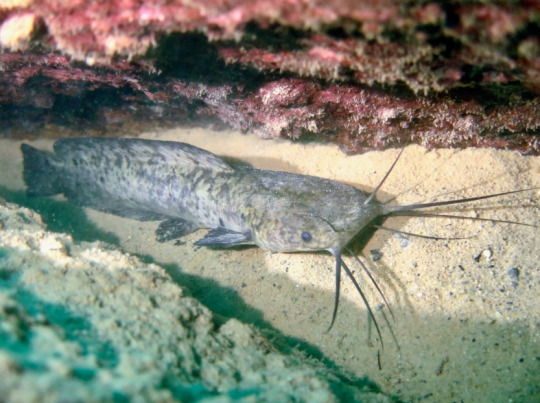
You get a Sharptooth Catfish
Clarias gariepinus
55 notes
·
View notes
Text
🐟 Fishuary 2024 Day Six: Catfish/Pleco
🐟

A quickie, but that is the point of drawing every day I suppose! Here is an African sharptooth catfish, or Clarias gariepinus! My uni keeps some for research purposes, it has a certain cuteness to it :)
@fish-daily
#i am not very comfortable with drawing catfish so im not quite as happy with this one as i am with the others#such is life sometimes! you live and you learn and you keep drawing#image description in alt#fish#art#my art#catfish#african sharptooth catfish#fishuary2024
60 notes
·
View notes
Video
youtube
Call of the wild the Angler-Izilo Zasendulo-African Sharptooth Catfish L...
0 notes
Text


Did not perform fishtime in a year. ouch. I am still kneedeep in the catfish, with no land in sight. but that only makes it more interresting how diverse this fishgroup is simply by tweaking small things here and there. Names under readmore
341 Bathyclarias foveolatus 342 Channallabes apus (eel catfish) 343 Clarias anguillaris 344 Clarias cavernicola (golden cave catfish) 345 Clarias gariepinus (African sharptooth catfish) 346 Clarias batrachus (walking catfish) 347 Gymnallabes nops (barely found anything on this one. so if someone with expertize would like to weigh in here: highly appreciated) 348 Gymnallabes typus 349 Heterobranchus longifilis (Vundu) 350 Ailia coila 351 Ailia punctata 352 Bagarius yarrelli (Goonch) 353 Bagarius suchus (crocodile catfish) 354 Gagata itchkeea 355 Bagrichthys macracanthus (blacklancer catfish) 356 Bagrus bajad (Bayad)
1 note
·
View note
Text
Just imagine, the alternate universe where Vee doesn't lock Target's armor and instead, Target realizes that there are HUGE fish in the river next to the treatment plant and his suit's waterproof and armored enough to go noodling
it changes the plot extremely little except now, on Bonfire night, they got a gigantic African Sharptooth Catfish to roast instead of just telling stories
meanwhile Duke's mental breakdown, instead of being over his alcoholism, is over the fact that the father figure of the squad is proud of someone else for catching a fish instead of him and he can't even drink to forget about it

Ada art
65 notes
·
View notes
Text
Photography: Wildlife Photographer of the Year Winners Show the Beauty — and Precarity — of Nature
— October 11, 2023 | By Rachel Treisman | NPR
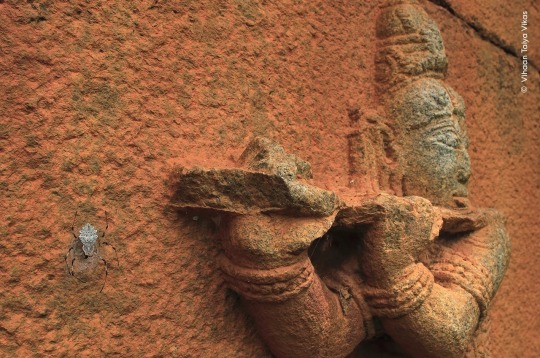
10 Years and Younger Winner: The wall of wonder. Nallur Heritage Tamarind Grove, Karnataka, India. An ornamental tree trunk spider prevents its prey from escaping. To the photographer, it seemed the spider had positioned its web after being entranced by the sound of Krishna's flute. Vihaan Talya Vikas/Wildlife Photographer of the Year

Animal Portraits Winner: Face of the forest. Tapiraí, São Paulo, Brazil. A lowland tapir steps cautiously out of the swampy Brazilian rainforest. They rely on the forest for their diet of vegetation and in turn they act as seed dispersers — an important relationship threatened by habitat loss, illegal hunting and traffic collision. Vishnu Gopal/Wildlife Photographer of the Year

Wetlands Winner: The dead river. Ciliwung river, Jakarta, Indonesia. Plastic and human waste and agricultural fertilizers are suffocating the Ciliwung river. As a result, Jakarta's residents must use groundwater for drinking water, which has resulted in widespread subsidence. The city is now sinking. Joan de la Malla/Wildlife Photographer of the Year

Steven Johnson highlights a lump of spotted salamander eggs resting on a bed of sphagnum moss in a vernal pool near Shenandoah National Park, Virginia. Shallow seasonal pools like these are ideal amphibian nurseries because they’re safe from predators like fish. But these habitats are impacted by environmental change: Less predictable spring rains are causing pools to dry up before the young salamanders can fully develop and live on land. Photograph By Steven Johnson, Wildlife Photographer of the Year
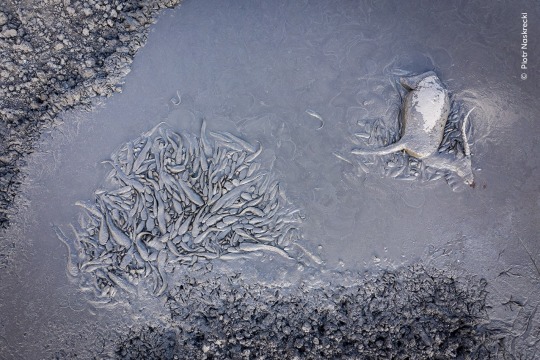
Piotr Neskrecki captured a group of African sharptooth catfish scavenging from a waterbuck that died after getting stuck in the mud—illustrating the cyclical nature of life at Gorongosa National Park in Mozambique 🇲🇿. Sharptooth catfish are omnivorous and can survive for several days out of water thanks to an air-breathing organ in their gills. If they do eventually perish while they wait for the rains to return, they provide food for other species. Photograph By Piotr Naskrecki, Wildlife Photographer of the Year
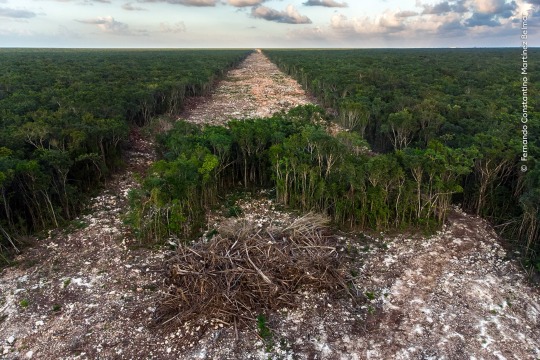
In this image, Mexican photographer Fernando Constantino Martínez Belmar shows how a new cross-country tourist railway line devastates the natural landscape in Paamul, Quintana Roo. The railway will bring economic benefits to southeast Mexico, but it also fragments the ecosystems, threatens protected reserves and archaeological sites, and impacts Indigenous peoples by destroying their land. Photograph By Fernando Constantino Martínez Belmar, Wildlife Photographer of the Year
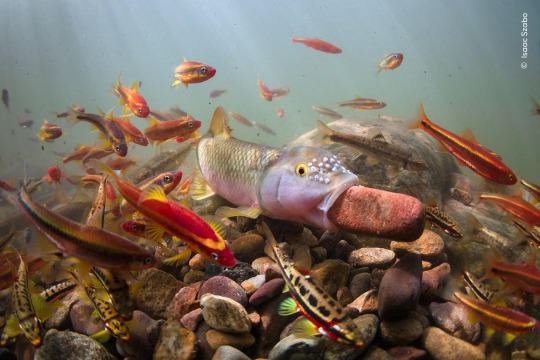
Isaac Szabo photographed different species gathered near a river chub’s nest in a freshwater stream in Virginia’s Whitetop Laurel Creek. During springtime spawning, male river chubs sometimes carry rocks and pebbles as far as 33 feet to form a mound where eggs can be sheltered from currents and predators. Other minnow species also use their nests to keep their eggs safe. Photograph By Isaac Szabo, Wildlife Photographer of the Year
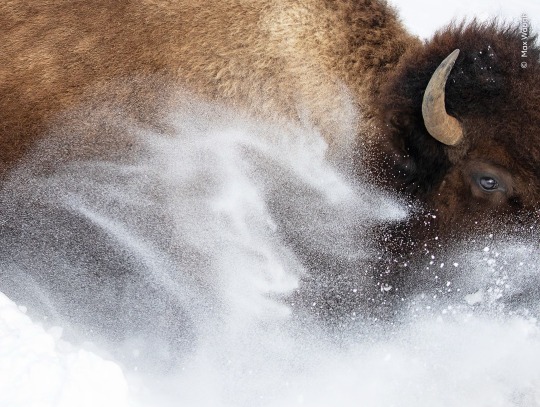
Max Waugh captured this bison barreling through the snow in Yellowstone National Park. Bison once roamed across North America, with populations of 50 to 60 million at the start of the 1800s—then less than a thousand at the end of the century. Today, their numbers are slowly increasing with careful conservation efforts. Photograph By Max Waugh, Wildlife Photographer of the Year
— Wildlife Photographer of the Year is developed and produced by the Natural History Museum in London.
0 notes
Text
The First Installation
When humans first set eyes on the colonies that emerged from the methane-filled volcanoes of the deep dark sea, their first thought wasn’t to name them, but to run. The names would come later. When they remembered certain familiar things about the number of legs and the humming in their heads and the hunger. Legions upon legions of hungry things with many legs and a constant buzzing. So when a name was needed the humans named them “Locust.” Vicious and biblical, they swarmed from the salty waters toward the land.
Before the legions emerged, the human mind would have struggled mightily to comprehend, much less name, the symbiotic beings-in-one-being that had been flung into the oceans so many years ago. Tucked away in places too hostile for something made of skin and crushable bone, the Locusts - more accurately called The Archetype - suffered and struggled and changed and adapted to their new home in the depths of the earth’s oceans. They reached out for food and chained themselves together like their cousins the siphonophores and threaded their thin filaments beyond the mud towers of hot methane.
They changed. And changed. And changed. And changed again. Until they could reach across every expanse of the great salt sea.
There, The Archetype learned to speak. Short electrical bursts at first. From the eels and the rays and the knifefish. They discovered the meaning of secrets from the eavesdropping sharptooth catfish and how to name things from the dolphins clicks. By the time they learned how the whales sing, they’d stretched their bioluminescent colonies across the ocean and turned their filaments toward the shore.
The earth’s air was as unkind as the crashing waves that broke their fine frames. But The Archetype persisted and created and changed and created again until it could reach its long tendrils beyond the sea and into the jungles and the marshes and the brackish bays.
With every reach, they touched, with every touch, they learned, but nothing changed until they touched the fine soft skin of a small flower clinging to a tree.
Then, everything changed.
It was a simple flower in appearance. Elegant in appearance though beauty had little use to The Archetype. They were far more interested in the elegance its evolution. It was a careful predator. One of opportunity, longevity and adaptability. It smiled as it ate. In all the time The Archetype had carefully - slowly, so slowly and patiently - explored the depths of the oceans and the edges of the land, only one other organism had spoken to them like the orchid.
The fungi had seemed the most promising as they reached their delicate tendrils from the oceans across the dirt. They were adaptable and long-living. Some were small. Some formed enormous networks and produced their own electrical currents and fields, spreading quick spikes and impulses across their webbed hyphae. The Archetype wanted to talk. Desperate to talk. But the fungi were volatile and hungry, producing acids that chewed through the slender reaching filaments the tapped gently at the door asking to be let in. Wounded, The Archetype pulled back and replenished, wondering if the whales had taught them the wrong songs.
Until they tried again and one slim little slither brushed the soft petal of a young orchid, and the entire colony paused.
WAIT.
The flower was not remarkable in appearance or external traits. It did not have an interesting heat signature and it did not sing. But when one of their thin watery tendril’s tapped the flower’s tiny leaves, it found a hungry heart within. Nearby fungi nurtured it. Served it. The Archetype paused and watched. The fungi fed the orchid and sometimes the flower reached down to the dark, dark, dark forest floor and fed its beleaguered companion a reward for its trouble. Several turns around the sun, and each relationship between flower and fungi differed. Now-healed tendrils reached out again, bolder now. Changed and adapted.
It looked for the orchids. Some had light and didn’t need fungi. The Archetype did not bother itself with these. Instead, it found and learned from the ones who needed light and did not have it and instead, gently installed themselves on other sources of energy. The ones that clung to trees and perched on the massive network in the soil below. Drawing everything it needed.
The Archetype realized how hungry it was.
Back in the salty sea, an idea tapped across long chambers and glowing chains of creatures young and old as they pushed themselves through the too-warm water. It started with the siphonophores and then moved quickly on. To the jellyfish and the lobsters and the fascinating, echoing octopus who showed them how to talk with its patterned skin. To the shapeless things in the dark with sharp teeth and glowing mouths.
The Archetype began to install itself. Like the orchid, it clung to what it needed. Then it changed. And changed again. And again. Until it’s host began to change too. Only a little at first. But The Archetype knew what it took to make colonies big and small. Knew to feed its oarsman and clean its sails and preen its feathers. It was not singular after all. Each iteration built from many, long before they were poured into the confusing liquid of the earth.
It adapted. It touched the orchids and the lampreys and the remoras and the cordyceps fungus. Learning and changing and it made new iterations of itself. New chains of organisms. Large and small. Simple and complex.
And then it was time. As the oceans grew too warm and the whalesongs more infrequent while dead coral leached into the water, The Archetype looked at the humans, ready to drag its many bodies from the ocean to fix the problem.
#The Butcher Bird#speculative fiction#evolution#fiction#snippet#alien invasion#surviving earth#dying earth#the beginning of the collapse#writeblr#writing#fiction writing#rough draft#worldbuilding#science fiction
3 notes
·
View notes
Text
South Africa: Shock Study - Eating Fish From the Klip River Can Give You Cancer
South Africa: Shock Study – Eating Fish From the Klip River Can Give You Cancer

The sharptooth catfish ( Clarias gariepinus ) – a source of food for people living along the Klip River in Gauteng – contains high levels of toxins that can cause cancer if eaten regularly.
The river flows through Soweto, Fleurhof and Lenasia where the catfish is consumed by residents daily.
According to a recently published study in Science of the Total Environment , the fish contain high…
View On WordPress
0 notes
Text
Check out the latest Post published on AfriShop
New Post has been published on http://ng.afrishoponline.com/product/table-size-catfish-for-sale/
Table Size Catfish For Sale (800g-1kg)
Growing catfish from fingerlings to table size is the most fun thing ever to do and on a large scale makes it more enthusiastic. A number of the questions bothering fish farmers or could be fish farmers have already been answered in this Fingerlings order page. A number of such questions include: •What Feed Size to Give Your Fingerlings Catfish? •Where do I buy my fingerlings? •Using what do I feed them? •Are they growing properly?
http://ng.afrishoponline.com/wp-content/uploads/2020/01/buy_table_size_catfish.mp4
Characteristic of the Table Size Catfish For Sale
Kingdom: Animalia Phylum: Chordata Class: Actinopterygii Order: Siluriformes Family: Clariidae Genus: Clarias Species: C. gariepinus D.S
High quality Table Size Catfish available. 100% Organic CP: 50% Location: Lagos Age: 5months from Fingerlings
Clarias gariepinus or African sharptooth catfish (Table size Catfish for sale above) can be found throughout Africa and the Middle East, and are living in freshwater lakes, rivers, and swamps, in addition to human-made habitats, such as for example concrete, tarpaulin as well as urban earthen pond systems. The African sharptooth catfish was introduced all around the world in the first 1980s for aquaculture purposes, so is within countries far outside its natural habitat, such as for example Brazil, Vietnam, Indonesia, and India.
Note: This Table size Catfish is specially raized for restaurants, big events and can also be found in local market or @AfriSmartFarms.
Contact this whatsapp line after your place
0 notes
Video
youtube
Call of the wild the Angler-Izilo Zasendulo-African Sharptooth Catfish L...
0 notes
Text
A chemical comparison between the golden and normal coloured strains of the African sharptooth catfish, Claria
http://dlvr.it/Psqs0Z
0 notes